
The Aegadian Islands are a group of five small mountainous islands in the Mediterranean Sea off the northwest coast of Sicily, Italy, near the cities of Trapani and Marsala, with a total area of 37.45 square kilometres (14.46 sq mi).

Genista is a genus of flowering plants in the legume family Fabaceae, native to open habitats such as moorland and pasture in Europe and western Asia. They include species commonly called broom, though the term may also refer to other genera, including Cytisus and Chamaecytisus. Brooms in other genera are sometimes considered synonymous with Genista: Echinospartum, Retama, Spartium, Stauracanthus, and Ulex.

Bituminaria is small genus of perennial herbs in the bean family. It includes 10 species, which range from Macaronesia through Mediterranean Basin of Europe, north Africa, and Western Asia to the Caucasus and Saudi Arabia.

Marettimo is one of the Aegadian Islands in the Mediterranean Sea west of Sicily, Italy. It forms a part of the municipality (comune) of Favignana in the Province of Trapani. It takes about an hour to reach the island from Trapani.
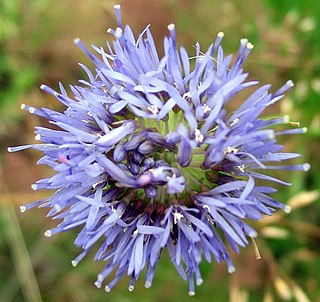
Jasione is a genus of flowering plants within the family Campanulaceae. It includes 14 species native to Europe, Turkey, and northwestern Africa.

Salsola is a genus of the subfamily Salsoloideae in the family Amaranthaceae. The genus sensu stricto is distributed in central and southwestern Asia, North Africa, and the Mediterranean. A common name of various members of this genus and related genera is saltwort, for their salt tolerance. The genus name Salsola is from the Latin salsus, meaning "salty".

Senecio leucanthemifolius is a plant common in sea-side in Mediterranean area.

The Tempest is a play by William Shakespeare, probably written in 1610–1611, and thought to be one of the last plays that he wrote alone. After the first scene, which takes place on a ship at sea during a tempest, the rest of the story is set on a remote island, where Prospero, a wizard, lives with his daughter Miranda, and his two servants: Caliban, a savage monster figure, and Ariel, an airy spirit. The play contains music and songs that evoke the spirit of enchantment on the island. It explores many themes, including magic, betrayal, revenge, and family. In Act IV, a wedding masque serves as a play-within-a-play, and contributes spectacle, allegory, and elevated language.

Adenocarpus is a genus of flowering plants in the family Fabaceae. It belongs to the subfamily Faboideae. The plants are broom-like shrubs with bright yellow flowers. The genus is native to the Mediterranean Basin and sub-Saharan Africa, but finds its highest diversity in Northwest Africa and the Iberian Peninsula.

Chiliadenus is a genus of flowering plants in the family Asteraceae.
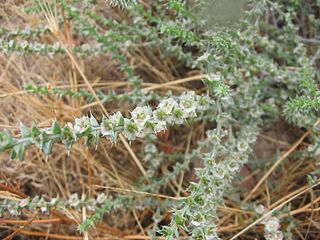
Kali was a genus of plants in the subfamily Salsoloideae in the family Amaranthaceae, that has now been subsumed into the genus Salsola.
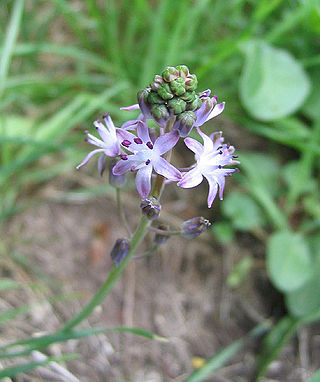
Prospero is a genus of bulbous flowering plants in the family Asparagaceae, subfamily Scilloideae. It is distributed in Europe, around the Mediterranean, and through the Middle East to the Caucasus.
Salvatore Brullo is professor at University of Catania since 1980 teaching Systematic Botany, he obtained a degree in natural science on July 1970. For six years he was Director of the Department of Botany, at the University of Catania.
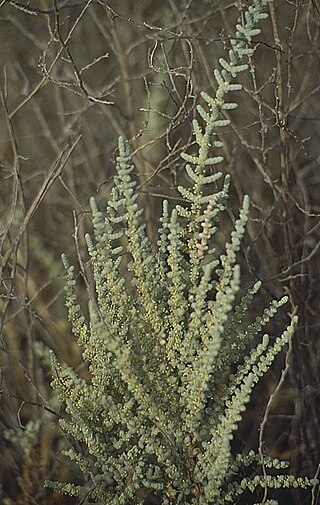
Halocnemum is a genus of halophytic shrubs in the family Amaranthaceae. The plants are fleshy and apparently articulated with characteristic globular or short-cylindrical lateral branches, and reduced leaves and flowers. There are three or two species, occurring from Southern Europe and North Africa to Asia.

Chiliadenus bocconei is a species of plant in the family Asteraceae. It is endemic to Malta.
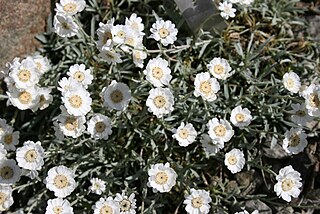
Achillea cretica, Cretan yarrow, is a species of flowering plant in the family Asteraceae, native to Greece, the East Aegean Islands, Crete, Turkey, and Cyprus. It is typically found in calcareous rocky areas such as cliffs, gorges, scree fields, and even ancient ruins, and is somewhat tolerant of salty conditions.














